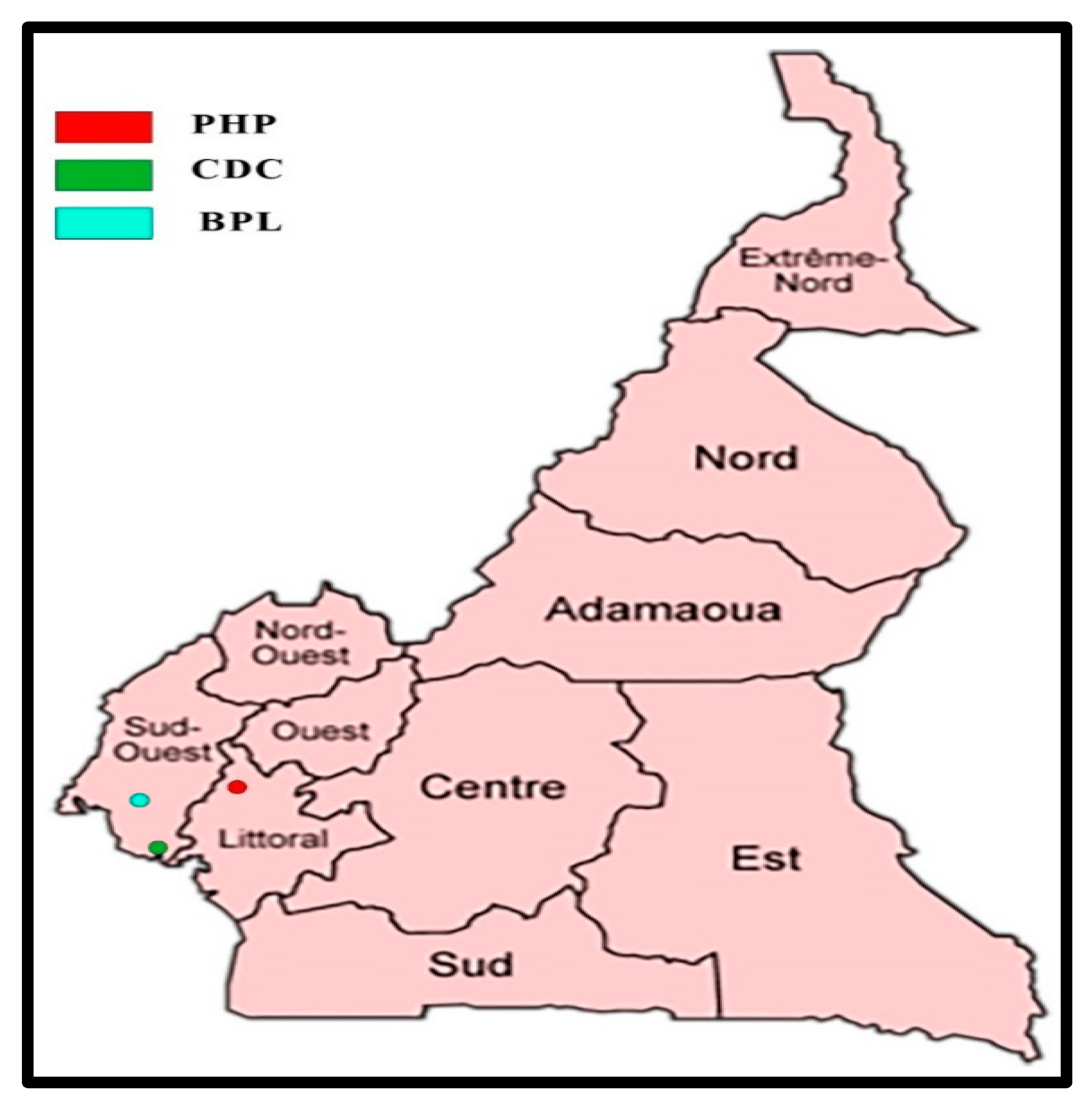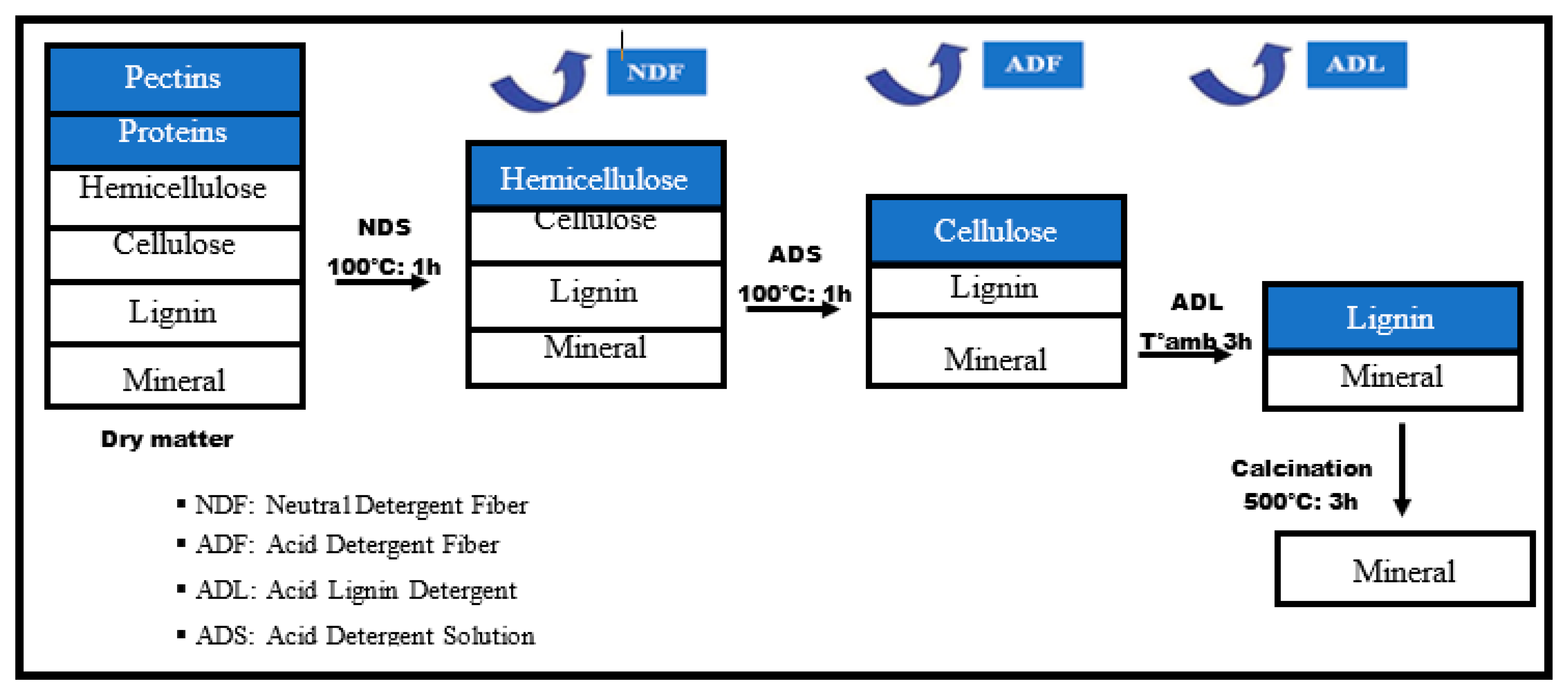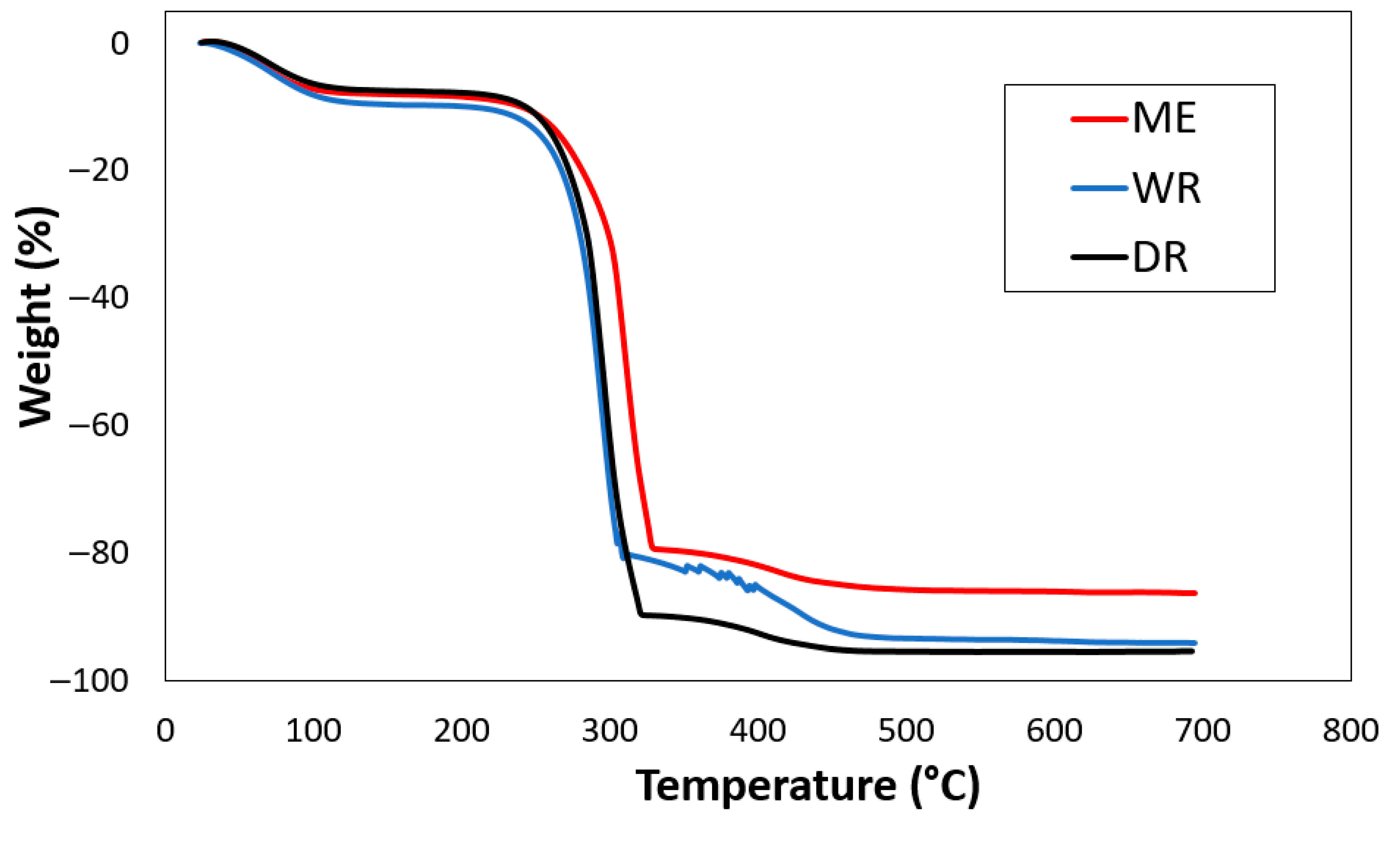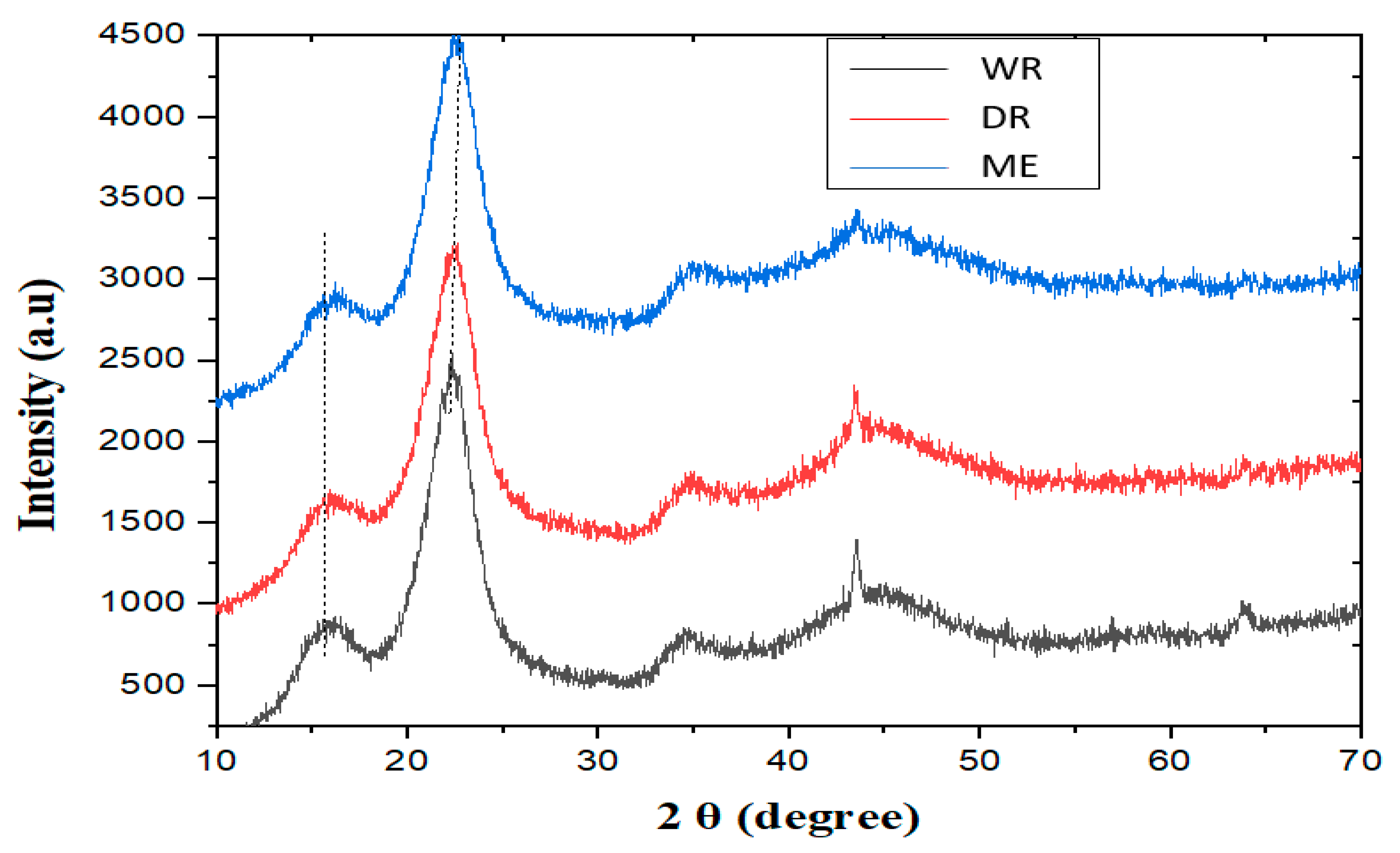Study of the Physical and Chemical Properties of Banana Peduncle Fibers of the Cultivar “William Cavendish”: Influence of Extraction Techniques
Highlights
- The fibres of the William banana peduncle are extracted by three methods and chemical analysis by Van Soest’s dry biomass fractionation method has shown that its fibers have a cellulose content of over 70%.
- Thermogravimetric analysis shows that banana peduncle fibers are thermally stable at 82 °C, and X-ray diffraction reveals a crystallinity rate of over 50%.
- The method of extracting fibers from dew is advantageous and economical; chemical analysis results show that WBPF is a good candidate for the production of non-woven fabrics.
- In the case of textiles developed from banana peduncle fibers, they can be used in applications that can withstand temperatures of around 80 °C without damage and crystallinity levels predispose the fibers to better mechanical properties.
Abstract
1. Introduction
2. Materials and Methods
2.1. Origin of Samples
2.2. Methods for Extracting Fibers from the Peduncle of William Banana (WBPF)
2.3. Physical–Chemical Characterization of William Peduncle Fibers
2.3.1. Study of the Chemical Composition of the Fiber
2.3.2. Scanning Electron Microscopy (SEM) Study of Extracted Fibers
2.3.3. Study of the Density and Moisture Content of WBPF
- : Moisture absorption in %;
- Mi: Initial mass in the anhydrous state;
- Mf: Final mass.
2.3.4. Thermogravimetric Analysis (TGA)
2.3.5. X-Ray Diffraction (XRD) Study
2.3.6. Study Using Fourier-Transform Infrared Spectroscopy (FTIR)
3. Results and Discussion
3.1. Study of Fiber Morphology
3.2. Analysis of the Chemical Composition, Density, and Moisture Content of WBPF
3.3. Analysis by Fourier-Transform Infrared Spectrometry (FTIR)
3.4. Thermogravimetric Analysis (ATG)
3.5. X-Ray Diffraction Analysis
4. Conclusions
Author Contributions
Funding
Data Availability Statement
Conflicts of Interest
References
- Pazmiño-Hernandez, M.; Moreira, C.M.; Pullammanappallil, P. Feasibility assessment of waste banana peduncle as feedstock for biofuel production. Biofuels 2019, 10, 473–484. [Google Scholar] [CrossRef]
- Perrier, X.; De Langhe, E.; Donohue, M.; Lentfer, C.; Vrydaghs, L.; Bakry, F.; Carreel, F.; Hippolyte, I.; Horry, J.-P.; Jenny, C.; et al. Multidisciplinary perspectives on banana (Musa spp.) domestication. Proc. Natl. Acad. Sci. USA 2011, 108, 11311–11318. [Google Scholar] [CrossRef] [PubMed]
- Lassois, L.; Busogoro, J.-P.; Jijakli, H. La banane: De son origine à sa commercialisation. Biotechnol. Agron. Soc. Environ. 2009, 13, 575–586. [Google Scholar]
- Vu, H.T.; Scarlett, C.J.; Vuong, Q.V. Phenolic compounds within banana peel and their potential uses: A review. J. Funct. Foods 2018, 40, 238–248. [Google Scholar] [CrossRef]
- Dury, S.; Bricas, N.; Tchango-tchango, J.; Temple, L.; Bikoi, A. The determinants of urban plantain consumption in Cameroon. Food Qual. Prefer. 2008, 13, 81–88. [Google Scholar] [CrossRef]
- Emaga, T.H.; Andrianaivo, R.H.; Wathelet, B.; Tchango, J.T.; Paquot, M. Effects of the stage of maturation and varieties on the chemical composition of banana and plantain peels. Food Chem. 2007, 103, 590–600. [Google Scholar] [CrossRef]
- FAO. La Situation Mondiale de L’alimentation et de L’agriculture: Investir Dans L’agriculture Pour un Avenir Meilleur; FAO: Rome, Italy, 2012. [Google Scholar]
- Kamdem, I.; Tomekpe, K.; Thonart, P. Production potentielle de bioéthanol, de biométhane et de pellets à partir des déchets de biomasse lignocellulosique du bananier (Musa spp.) au Cameroun. Biotechnol. Agron. Soc. Environ. 2011, 15, 471–483. [Google Scholar]
- Manimaran, P.; Pillai, G.P.; Vignesh, V.; Prithiviraj, M. Characterization of natural cellulosic fibers from Nendran Banana Peduncle plants. Int. J. Biol. Macromol. 2020, 162, 1807–1815. [Google Scholar] [CrossRef] [PubMed]
- Durai, P.N.; Viswalingam, K. Suitability Assessment of Musa Acuminate Peduncles Fiber for Fabrication of Green Composites. J. Nat. Fibers 2022, 19, 14866–14879. [Google Scholar] [CrossRef]
- Manimaran, P.; Sanjay, M.R.; Senthamaraikannan, P.; Jawaid, M.; Saravanakumar, S.S.; George, R. Synthesis and characterization of cellulosic fiber from red banana peduncle as reinforcement for potential applications. J. Nat. Fibers 2019, 16, 768–780. [Google Scholar] [CrossRef]
- Pillai, G.P.; Manimaran, P.; Vignesh, V. Physico-chemical and Mechanical Properties of Alkali-Treated Red Banana Peduncle Fiber. J. Nat. Fibers 2020, 18, 2102–2111. [Google Scholar] [CrossRef]
- Preethi, P.; Balakrishna Murthy, G. Physical and Chemical Properties of Banana Fiber Extracted from Commercial Banana Cultivars Grown in Tamilnadu State. Agrotechnology 2013, 8, 1–3. [Google Scholar] [CrossRef]
- Haman, Z.; Korgaï, D.; Mejouyo, H.P.W.; Justin, B.T.D.; Hambate, G.V. Analysis of Some Technological Properties of Textile Fibers From the Banana Tree Stalk. Can. J. Pure Appl. Sci. 2022, 16, 5467–5473. [Google Scholar]
- Lyu, P.; Zhang, Y.; Wang, X.; Hurren, C. Degumming methods for bast fibers—A mini review. Ind. Crops Prod. 2021, 174, 114158. [Google Scholar] [CrossRef]
- Anafack, S.M.; Harzallah, O.; Nkemaja, E.D.; Huisken, P.W.M.; Drean, J.Y.; Murugesh, B.K. Effects of extraction techniques on textile properties of William banana peduncle fibers. Ind. Crops Prod. 2023, 201, 116912. [Google Scholar] [CrossRef]
- Bleuze, L.; Chabbert, B.; Lashermes, G.; Recous, S. Hemp harvest time impacts on the dynamics of microbial colonization and hemp stems degradation during dew retting. Ind. Crops Prod. 2020, 145, 112122. [Google Scholar] [CrossRef]
- Martin, M.A.N. Contribution à L’étude de Paramètres Influençant Les Propriétés Mécaniques de Fibers Élémentaires de Lin: Corrélation Avec Les Propriétés de Matériaux Composites. Ph.D. Thesis, Université Européenne de Bretagne, Rennes, France, 2015. [Google Scholar]
- Chabbert, B.; Padovani, J.; Djemiel, C.; Ossemond, J.; Lemaître, A.; Yoshinaga, A.; Hawkins, S.; Grec, S.; Beaugrand, J.; Kurek, B. Multimodal assessment of flax dew retting and its functional impact on fibers and natural fiber composites. Ind. Crops Prod. 2020, 148, 112255. [Google Scholar] [CrossRef]
- Amel, B.A.; Paridah, M.T.; Sudin, R.; Anwar, U.; Hussein, A.S. Effect of fiber extraction methods on some properties of kenaf bast fiber. Ind. Crops Prod. 2013, 46, 117–123. [Google Scholar] [CrossRef]
- Van Soest, P.J.; Wine, R.H. Use of Detergents in the Analysis of Fibrous Feeds. IV. Determination of Plant Cell-Wall Constituents. J. Assoc. Off. Anal. Chem. 1967, 50, 50–55. [Google Scholar] [CrossRef]
- Guitet, A. Adaptation de la Méthode “Fractionnement Biochimique Selon Van Soest” Appliqué Aux Échantillons de Composts via un Plan D’experience. Master’s Thesis, 2012. Available online: https://theses.hal.science/tel-01153478/file/BETENE_EBANDA_2012CLF22298.pdf (accessed on 10 July 2025).
- Peltre, C.; Dignac, M.; Derenne, S.; Houot, S. Change of the chemical composition and biodegradability of the Van Soest soluble fraction during composting: A study using a novel extraction method. Waste Manag. 2010, 30, 2448–2460. [Google Scholar] [CrossRef] [PubMed]
- Ebanda, F.B. Etude des Propriétés Mécaniques et Thermiques du Plâtre Renforcé de Fibers Végétales Tropicales. Ph.D. Thesis, Université Blaise Pascal—Clermont-Ferrand II, Aubière, France, 2012. [Google Scholar]
- Atalie, D.; Gideon, R.K. Extraction and characterization of Ethiopian palm leaf fibers. Res. J. Text. Appar. 2018, 22, 15–25. [Google Scholar] [CrossRef]
- Betene, A.D.O.; Betene, F.E.; Martoïa, F.; Dumont, P.J.J.; Atangana, A.; Noah, P.M.A. Physico-Chemical and Thermal Characterization of Some Lignocellulosic Fibres: Ananas comosus (AC), Neuropeltis acuminatas (NA) and Rhecktophyllum camerunense (RC). J. Miner. Mater. Charact. Eng. 2020, 8, 205–222. [Google Scholar] [CrossRef]
- Segal, L.; Creely, J.J.; Martin, A.E., Jr.; Conrad, C.M. An Empirical Method for Estimating the Degree of Crystallinity of Native Cellulose Using the X-Ray Diffractometer. Text. Res. J. 1959, 29, 786–794. [Google Scholar] [CrossRef]
- Kathirselvam, M.; Kumaravel, A.; Arthanarieswaran, V.P.; Saravanakumar, S.S. Isolation and characterization of cellulose fibers from Thespesia populnea barks: A study on physicochemical and structural properties. Int. J. Biol. Macromol. 2019, 129, 396–406. [Google Scholar] [CrossRef] [PubMed]
- Vignesh, V.; Balaji, A.N.; Karthikeyan, M.K.V. Extraction and characterization of new cellulosic fibers from Indian mallow stem: An exploratory investigation. Int. J. Polym. Anal. Charact. 2016, 21, 504–512. [Google Scholar] [CrossRef]
- Baley, C. Fibers naturelles de renfort pour matériaux composites. Tech. L’ingénieur 2020, 33, 1–37. [Google Scholar]
- Madhu, P.; Sanjay, M.R.; Senthamaraikannan, P.; Pradeep, S.; Saravanakumar, S.S.; Yogesha, B. A review on synthesis and characterization of commercially available natural fibers: Part-I. J. Nat. Fibers 2018, 16, 1132–1144. [Google Scholar] [CrossRef]
- Asim, M.; Paridah, M.T.; Chandrasekar, M.; Shahroze, R.M.; Jawaid, M.; Nasir, M.; Siakeng, R. Thermal stability of natural fibers and their polymer composites. Iran. Polym. J. 2020, 29, 625–648. [Google Scholar] [CrossRef]
- Atiqah, A.; Jawaid, M.; Ishak, M.R.; Sapuan, S.M. Effect of Alkali and Silane Treatments on Mechanical and Interfacial Bonding Strength of Sugar Palm Fibers with Thermoplastic Polyurethane. J. Nat. Fibers 2018, 15, 251–261. [Google Scholar] [CrossRef]
- NagarajaGanesh, B.; Muralikannan, R. Extraction and characterization of lignocellulosic fibers from Luffa cylindrica fruit. Int. J. Polym. Anal. Charact. 2016, 21, 259–266. [Google Scholar] [CrossRef]
- Senthamaraikannan, P.; Kathiresan, M. Characterization of raw and alkali treated new natural cellulosic fiber from Coccinia grandis L. Carbohydr. Polym. 2018, 186, 332–343. [Google Scholar] [CrossRef] [PubMed]
- Nagaraj, N.; Balasubramaniam, S.; Venkataraman, V.; Manickam, R.; Nagarajan, R.; Oluwarotimi, I.S. Effect of cellulosic filler loading on mechanical and thermal properties of date palm seed/vinyl ester composites. Int. J. Biol. Macromol. 2020, 147, 53–66. [Google Scholar] [CrossRef] [PubMed]
- Yang, H.; Yan, R.; Chen, H.; Lee, D.H.; Zheng, C. Characteristics of hemicellulose, cellulose and lignin pyrolysis. Fuel 2007, 86, 1781–1788. [Google Scholar] [CrossRef]
- Palai, B.K.; Sarangi, S.K. Characterization of Untreated and Alkalized Eichhornia Crassipes Fibers and Its Composites. J. Nat. Fibers 2020, 19, 3809–3824. [Google Scholar] [CrossRef]
- Palai, B.K.; Sarangi, S.K.; Mohapatra, S.S. Investigation of Physiochemical and Thermal Properties of Eichhornia Crassipes Fibers. J. Nat. Fibers 2019, 18, 1320–1331. [Google Scholar] [CrossRef]
- Belouadah, Z.; Ati, A.; Rokbi, M. Optimisation Des Méthodes D ’extraction Et Caractérisation Mécanique De La Fiber Alfa En Vue De Son Application Comme Renfort Des Matériaux Composites. J. Mater. Process. Environ. 2014, 2, 51–57. [Google Scholar]
- Dallel, M. Evaluation du Potentiel Textile Des Fibers D’alfa (Stipa tenacissima L.): Caractérisation Physico-Chimique de la Fibre au Fil. Ph.D. Thesis, Université de Haute Alsace, Mulhouse, France, 2013. [Google Scholar]
- Sanjay, M.R.; Madhu, P.; Jawaid, M.; Senthamaraikannan, P.; Senthil, S.; Pradeep, S. Characterization and properties of natural fiber polymer composites: A comprehensive review. J. Clean. Prod. 2018, 172, 566–581. [Google Scholar] [CrossRef]






| Code | Meanings |
|---|---|
| WR | Water retting |
| DR | Dew retting |
| ME | Mechanical extraction |
| Fibers | Extraction Methods | Cellulose (%) | Hemicellulose (%) | Lignin (%) | Density (g/cm)3 | Moisture Content (%) | Ref |
|---|---|---|---|---|---|---|---|
| Hemp | Water retting | 72 | 10 | 3.0 | 0.86 | ND | [31,32] |
| Flax | Water retting | 79 | 11 | 3.0 | 1.30 | ND | [31,32] |
| Jute | Water retting | 59–71 | 12–13 | 11.8–12.9 | 1.45 | ND | [31,32] |
| Sisal | Water retting | 60–67 | 10–15 | 8–12 | 1.26–1.33 | ND | [31,32] |
| Ramie | Water retting | 68.6–91 | 5–16.7 | 0.6–0.7 | ND | ND | [31,32] |
| Kenaf | Water retting | 44–57 | 21 | 15–19 | ND | ND | [31,32] |
| Nendran banana | Water retting | 73.20 | 10.85 | 15.32 | 0.97 | 9.01 | [9] |
| Nain banana | Mechanical extraction | 48.31 | 13.99 | 19.87 | ND | ND | [13] |
| Poovan banana | Mechanical extraction | 56.24 | 14.89 | 19.17 | ND | ND | [13] |
| Monthan banana | Mechanical extraction | 49.65 | 15.75 | 20.66 | ND | ND | [13] |
| Nendran banana | Mechanical extraction | 60.41 | 10.20 | 17.56 | ND | ND | [13] |
| Musa acuminata | Water retting | 66.43 | 13.72 | 16.85 | 0.942 | 12.05 | [10] |
| Red banana | Water retting | 73.20 | 11.01 | 15.11 | 0.99 | 9.36 | [11] |
| Red banana | Chemical extraction | 79.13 | ND | 12.3 | 0.85 | 7.51 | [12] |
| Careya arborea treeJeevan | Retting extraction | 71.8 | 21.86 | 14.95 | 1.40 | ND | [33] |
| Abyssinia banana | Retting extraction | 52.14 | 12.91 | 9.10 | ND | ND | [34] |
| William banana peduncle | Water retting | 71.8 | 14.6 | 8.6 | 0.933 | 9.62 | This work |
| Dew retting | 73.6 | 12.8 | 5.7 | 0.938 | 6.66 | This work | |
| Mechanical extraction | 74.8 | 12.8 | 7.1 | 0.933 | 8.10 | This work |
| Position of Peaks (cm)−1 | Functional Group | Chemical Composition | References |
|---|---|---|---|
| 3320 | O-H stretching | Cellulose | [33,36,37] |
| 2898 | Asymmetric stretching C-H and CH2 | Cellulose and hemicellulose | [9,29,34] |
| 1629 | Symmetrical stretching | Lignin and hemicellulose | [9,35] |
| 1030 | C-OH stretching | Lignin | [9,35,37] |
| Extraction Methods | Dégradation Température (°C) | ||
|---|---|---|---|
| 1ère Phase | 2ème Phase | 3ème Phase | |
| WR | [82 (9.66%)] | [301 (74.51%)] | [426 (12.90%)] |
| DR | [76 (6.68%)] | [319 (49.97%)] | [439 (19.96%)] |
| ME | [66 (8.15%)] | [316 (70.76%)] | [457 (4.80%)] |
| Natural Fibers | Amorphous Fractions at 2θ | Crystalline Fractions at 2θ | Crystallinity Index (%) | Reference |
|---|---|---|---|---|
| Nendran banana | 15.34 | 24.16 | 53.30 | [9] |
| Red banana | 15.92 | 22.17 | 62.1 | [11] |
| Musa acuminata banana | 14.93 | 21.89 | 36.47 | [10] |
| Red banana-treated | 14.52 | 24.15 | 64.57 | [12] |
| Linen | 18 | 22 | 70 | [42] |
| Ramie | 18 | 22 | 58 | [42] |
| Sisal | 18 | 26 | 75 | [42] |
| Hemp | 16.6 | 22 | 87.9 | [42] |
| Jute | 18.5 | 22.5 | 58.90 | [42] |
| WR | 16.09 | 22.67 | 58.24 | This work |
| DR | 16.09 | 22.67 | 54.83 | This work |
| ME | 16.09 | 22.67 | 69.53 | This work |
Disclaimer/Publisher’s Note: The statements, opinions and data contained in all publications are solely those of the individual author(s) and contributor(s) and not of MDPI and/or the editor(s). MDPI and/or the editor(s) disclaim responsibility for any injury to people or property resulting from any ideas, methods, instructions or products referred to in the content. |
© 2025 by the authors. Licensee MDPI, Basel, Switzerland. This article is an open access article distributed under the terms and conditions of the Creative Commons Attribution (CC BY) license (https://creativecommons.org/licenses/by/4.0/).
Share and Cite
Anafack, S.M.; Mejouyo Huisken, P.W.; Drean, J.-Y.; Harzallah, O.; Nicodème Sikame Tagne, R.; Tamaguelon Dzoujo, H.; Babu, M.; Njeugna, E. Study of the Physical and Chemical Properties of Banana Peduncle Fibers of the Cultivar “William Cavendish”: Influence of Extraction Techniques. Fibers 2025, 13, 153. https://doi.org/10.3390/fib13110153
Anafack SM, Mejouyo Huisken PW, Drean J-Y, Harzallah O, Nicodème Sikame Tagne R, Tamaguelon Dzoujo H, Babu M, Njeugna E. Study of the Physical and Chemical Properties of Banana Peduncle Fibers of the Cultivar “William Cavendish”: Influence of Extraction Techniques. Fibers. 2025; 13(11):153. https://doi.org/10.3390/fib13110153
Chicago/Turabian StyleAnafack, Solange Mélanie, Paul William Mejouyo Huisken, Jean-Yves Drean, Omar Harzallah, Rodrigue Nicodème Sikame Tagne, Hermann Tamaguelon Dzoujo, Murugesh Babu, and Ebenezer Njeugna. 2025. "Study of the Physical and Chemical Properties of Banana Peduncle Fibers of the Cultivar “William Cavendish”: Influence of Extraction Techniques" Fibers 13, no. 11: 153. https://doi.org/10.3390/fib13110153
APA StyleAnafack, S. M., Mejouyo Huisken, P. W., Drean, J.-Y., Harzallah, O., Nicodème Sikame Tagne, R., Tamaguelon Dzoujo, H., Babu, M., & Njeugna, E. (2025). Study of the Physical and Chemical Properties of Banana Peduncle Fibers of the Cultivar “William Cavendish”: Influence of Extraction Techniques. Fibers, 13(11), 153. https://doi.org/10.3390/fib13110153






